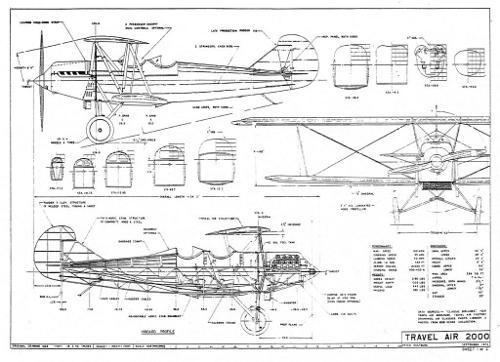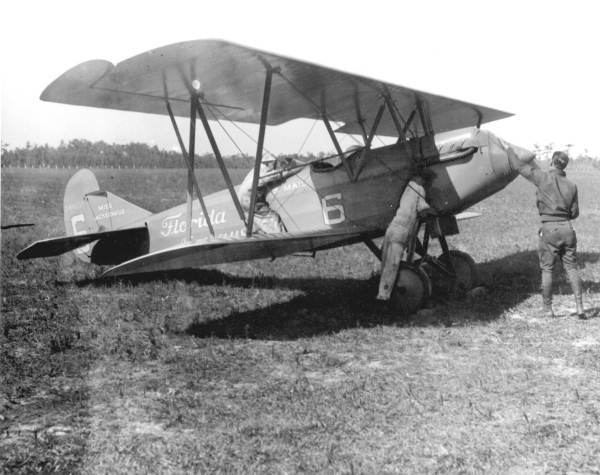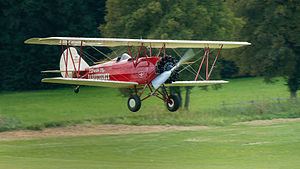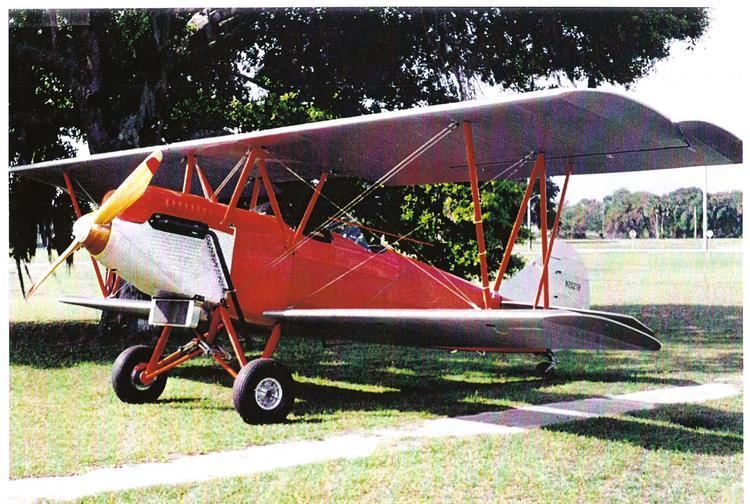Number built approx 1,300 | Produced 1925–1930 First flight 13 March 1925 | |
 | ||
Manufacturers Curtiss-Wright, Travel Air | ||
Travel air 2000
The Travel Air 2000/3000/4000 (originally, the Model A, Model B and Model BH and later marketed as a Curtiss-Wright product under the names CW-14, Speedwing, Sportsman and Osprey), were open-cockpit biplane aircraft produced in the United States in the late 1920s by the Travel Air Manufacturing Company. During the period from 1924-1929, Travel Air produced more aircraft than any other American manufacturer, including over 1,000 biplanes (some estimates range from 1,200 to nearly 2,000).
Contents
- Travel air 2000
- Primary design and development
- Steam powered
- Curtiss Wright production
- Operational history
- Normal Operations
- Military Operations
- Movie Industry
- Variants
- Curtiss Wright models built
- Military operators
- Aircraft on display
- Surviving aircraft
- Specifications CW A14D
- References

Primary design and development

The original Travel Air Model A was engineered chiefly by Lloyd Stearman—with input from Travel Air co-founders Walter Beech, Clyde Cessna, and Bill Snook—largely as a metal-framed improvement of his immediately previous design of the wood-framed, metal-cowled Swallow New Swallow biplane, with elements of the best fighter aircraft of World War I, the metal-framed German Fokker D.VII. Most subsequent Travel Air biplanes were derived, directly or indirectly, from the original Model A.


The types shared a common structure of a conventional single-bay biplane with staggered wings braced by N-struts. The fuselage was of fabric-covered steel tube and included two open cockpits in tandem, the forward of which could carry two passengers side-by-side.

In common with the Fokker D.VII, the rudder and ailerons of first Travel Air biplanes had an overhanging "horn" to partially aerodynamically counterbalance the aerodynamic resistance of the controls when deflected, to provide a lighter control feel, and a more responsive aircraft. This gave Travel Airs their distinctive "elephant ear" vertical tails, and the similarly counterbalanced ailerons were also referred to as "elephant ear" ailerons—leading to the airplane's popular nicknames "Old Elephant Ears" and "Wichita Fokker." Some subsequent models were offered without the counterbalance, providing a cleaner, more conventional appearance and less drag. Elevator forces were trimmed out by use of an inflight-adjustable horizontal stabilizer.

Like other aircraft in the Travel Air line, it was available with a variety of different, interchangeable wings, including a wing shorter and thinner than the rest known as the "Speedwing" designed, as the name suggests, for increased cruise speed. Travel Air entered a specially-modified Model 4000 (designated 4000-T) in the Guggenheim Safe Aircraft Competition of 1930, but it was disqualified.
Compared to other civilian ("commercial") open-cockpit biplanes of the era, Travel Airs were noted for their quality of construction, reliability, durability, speed, efficiency, payload and passenger capacity (two passengers in a small bench seat in the front cockpit, plus pilot in the rear cockpit—versus most biplanes of the era, which could only accommodate a single passenger in the front cockpit). They were also noted for superior comfort and easy flying. These various distinguishing characteristics led Travel Air to outsell all rivals by 1929.
Steam-powered
In 1933 a Travel Air 2000 was modified by George and William Besler where the usual inline or radial gasoline piston engine was replaced by an oil-fired, reversible 90° angle V-twin angle-compound engine of their own design, which became the first fixed-wing airplane to successful fly using a steam engine of any type. The Beslers are thought to have sold the plane to the Japanese in 1937.
Curtiss-Wright production
Following Travel Air Manufacturing Company purchase in August 1929 by Curtiss-Wright, the Model 4000 continued in production into the early 1930s as the CW-14, and the range was expanded to include a military derivative dubbed the Osprey. This was fitted with bomb racks, a fixed, forward-firing machine gun, and a trainable tail gun. These aircraft were supplied to Bolivia and used during the Gran Chaco War, which eventually led to Curtiss-Wright's successful prosecution for supplying these aircraft in violation of a U.S. arms embargo.
Operational history
In addition to a wide range of normal aircraft applications, and conspicuous use in a minor South American war, Travel Air biplanes also saw extensive use in early motion pictures.
Normal Operations
During the 1920s and very early 1930s, Travel Air biplanes were the most widely used civilian biplanes in America (not counting war-surplus military trainers re-purposed for civilian use) -- with the arguable exception of their chief competitors, WACO biplanes. (Travel Air production ended in the mid-1930s, under the Curtiss-Wright Corporation).
Initially, Travel Air biplanes were very widely used for executive transport, wealthy-sportsmen adventures, air taxi and air charter service, light air cargo tramsport, and some bush flying. Many were also used in barnstorming: exhibition and stunt flying, selling recreational rides, and early air racing.
Commercial opeartors found the Travel Air biplanes very versatile and useful, owing to their substantial payload, simple and reliable systems, rugged construction and (for the times) substantial speed and efficiency.
Towards the end of their useful lives (the late-1930s through the early 1970s), they were heavily used for the harsh work of bush flying and cropdusting, and Travel Air biplanes were among the most heavily used cropdusters in America—perhaps second only to the World War II surplus Stearman Kaydet biplanes (also designed by Lloyd Stearman).
Today, most remaining Travel Air biplanes are regarded as treasures, having been carefully restored at substantial cost, and are used sparingly and carefully for personal recreation and/or modern-day barnstorming (exhibition flying and selling rides).
Military Operations
The Osprey, a Travel Air biplane variant by Curtiss-Wright, was armed with bomb racks and machine guns, and supplied to Bolivia, who used them in the 1933 Gran Chaco War with Paraguay (in violation of a U.S. arms embargo, for which Curtiss-Wright's was eventually successfully prosecuted). Numerous plane-makers attempted to get their aircraft into the war, for publicity, and the Osprey initially benefitted the most from this international competition. Fitted with single machine guns fore (fixed) and aft (moveable), and bomb racks, the rugged, reliable Ospreys were the preferred mounts of the Bolivian pilots—of several competing aircraft supplied. The resulting heavy use led to high losses—half of the original 12 units being lost in accidents or action, another 5 or so were employed, though precise outcomes are unclear, owing in part to repairs on some of the "lost" aircraft, which were returned to service. However, the action brought favorable publicity and credibility to Curtiss-Wright aircraft.
Movie Industry
Travel Air biplanes were widely used in 1920s/1930s war movies, particularly to represent the airplanes they were patterned after: Germany's Fokker D-VII fighter, the top fighter of World War I. In the motion picture industry, they were known as "Wichita Fokkers." In fact, Hollywood's demand for Travel Air biplanes was so intense that Travel Air's California salesman, Fred Hoyt, coaxed Travel Air co-founder and principal airplane designer, Lloyd Stearman, to come to Venice, California in 1926 to exploit the movie industry demand for his aircraft by starting a short-lived independent Stearman Aircraft Company (re-opened back in Wichita in 1927).
Some of the many movies using Travel Air biplanes (2000 and 4000, in particular) included:
Variants
Like other Travel Air aircraft, Model 4000 variants were distinguished by letters prefixed (or occasionally affixed) to the basic designation to denote different engine and wing fits. These letter codes included:
Curtiss-Wright models built
Military operators
Aircraft on display
Museum aircraft include:
Surviving aircraft
A number of Travel Air biplanes and monoplanes participated in the 2003 National Air Tour, and the 2008 American Barnstormers Tour.
A Travel Air 2000, stored since 1937, was restored and flown in 2014.
An airworthy Travel Air 4000 is flown regularly by Northwest Airlines captain Clay Adams, (a.k.a. "Nostalgic Wings"), at airshows and fly-ins around the nation, selling rides. Along with other Travel Air biplanes, Adams' 4000 participated in the 2003 National Air Tour and the 2006 and 2008 American Barnstormers Tour, which Adams organized., and flew in 2003 for the TV-documentary film The Barnstormers
An airworthy Travel Air 4000 resides in the collection of Fantasy of Flight in Polk City, Florida. In 1997, this aircraft was used by the U.S. Postal Service to help commemorate the first day issue of a series of airplane stamps. With the local Postmaster on board, owner Kermit Weeks delivered the first ever airmail in the history of Polk City; probably the last as well.
Specifications (CW-A14D)
Data from Specifications of American Airplanes
General characteristics
Performance
